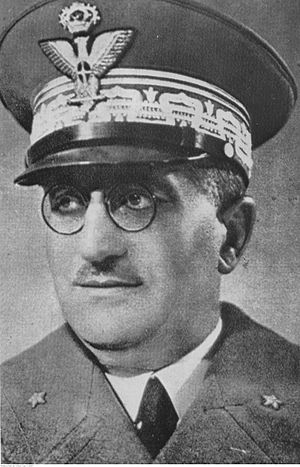Ugo Cavallero facts for kids
Quick facts for kids
Ugo Cavallero
|
|
|---|---|
 |
|
| Born | 20 September 1880 Casale Monferrato, Piedmont, Italy |
| Died | 13 September 1943 (aged 62) Frascati, Lazio, Italy |
| Allegiance | |
| Service/ |
|
| Years of service | 1900–1943 |
| Rank | Marshal of Italy |
| Commands held | Chief of the Defence Staff |
| Battles/wars | Italo-Turkish War World War I World War II |
| Awards | Knight's Cross of the Iron Cross Order of the German Eagle (1st class) |
Ugo Cavallero (born September 20, 1880 – died September 13, 1943) was an important Italian military leader. He served in the army before and during World War II. His time as a commander ended, and he was arrested when Benito Mussolini's government fell. Later, German forces freed him. However, he did not want to work with them and was found dead the next day.
Contents
Ugo Cavallero's Life and Military Career
Early Life and Start in the Army
Ugo Cavallero was born in Casale Monferrato, a town in Piedmont, Italy. He came from a noble family, which meant he had a good start in life.
He went to military school and became a second lieutenant in the army in 1900. Later, he studied at college and earned a degree in mathematics in 1911. Cavallero was very smart and could speak both German and English fluently.
In 1913, he fought in Libya during the Italo-Turkish War. For his bravery, he received a special award called the Bronze Medal of Military Valor.
World War I Service
In 1915, Cavallero joined the main Italian military command. He was very good at organizing and planning battles. By 1918, he became a brigadier general and led the Operations Office for the Italian army.
He played a key role in planning important Italian victories. These included the battles at Piave and Vittorio Veneto during World War I. During this time, he had disagreements with Pietro Badoglio, who was another high-ranking officer.
Between the World Wars
Cavallero left the army in 1919, but he rejoined in 1925. At this time, he became an assistant to Benito Mussolini, who was Italy's leader. Cavallero supported the fascist movement.
In 1926, he became a senator, which is a member of the government. By 1927, he was promoted to major general. After leaving the army again, he worked in business and diplomacy in the late 1920s and early 1930s.
He returned to the army for the last time in 1937. He was promoted to lieutenant general. In 1938, he took command of all Italian forces in Italian East Africa. By 1940, he became a full general.
Role in World War II
After Italy joined World War II, Ugo Cavallero became the Chief of the Defence Staff on December 6, 1940. He took over this important role from Pietro Badoglio.
Soon after, Cavallero was sent to lead Italian forces in the Greco-Italian War. This war was not going well for Italy. He managed to stop the Greek army's advance, but he could not win the war alone. The situation only changed when German forces stepped in to help in the spring of 1941.
In 1941, Cavallero made changes to how the Italian military was organized. He turned the main military staff into a more powerful command center called Comando Supremo. Under Cavallero, Comando Supremo worked well with the German forces in Italy.
Cavallero worked closely with German Field Marshal Albert Kesselring. However, he often disagreed with Field Marshal Erwin Rommel. Rommel wanted to push into Egypt, but Cavallero thought Italy should focus on invading Malta instead. His idea was supported by Kesselring, but Adolf Hitler and Mussolini chose Rommel's plan.
Cavallero was promoted to Marshal of Italy on July 1, 1942. This happened soon after Rommel received the same rank. This promotion helped ensure Cavallero remained a high-ranking officer. He understood the challenges Italy faced in the Mediterranean Sea. However, he often agreed with Mussolini's ideas, even when they spread Italy's limited resources too thin. For example, he supported sending more Italian troops to fight on the Eastern Front.
In January 1943, Italy lost the war in Africa. The Italian army also faced big problems in Russia. Because of these setbacks, Cavallero was removed from his position. General Vittorio Ambrosio took his place. Some Fascist leaders, who did not like Cavallero, were happy about his dismissal.
After Mussolini's government fell, the new leader, Pietro Badoglio, ordered Cavallero's arrest. Cavallero wrote a document saying he had been against Mussolini. In September 1943, after Italy signed an armistice (a peace agreement), German forces freed him. A German general offered Cavallero a command role in a new Italian army that was forming. However, the letter he wrote earlier made some people doubt his loyalty.
His Death
On the morning of September 14, 1943, Ugo Cavallero was found dead. He had been shot in the garden of a hotel in Frascati. The night before, he had eaten and talked with General Kesselring. It seems he strongly refused to continue working with the Germans.
Awards
- Knight's Cross of the Iron Cross on February 19, 1942. This was a very high military award from Germany.
See also
 In Spanish: Ugo Cavallero para niños
In Spanish: Ugo Cavallero para niños
- Royal Italian Army
- Royal Italian Army (1940–1946)


